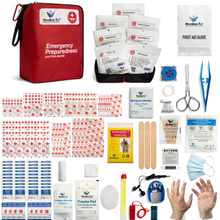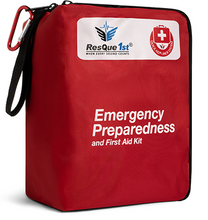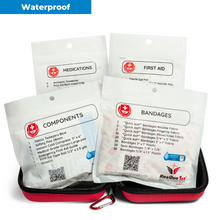
It seems like the first aid kit has been around forever. It hasn’t. In fact, the first aid kit’s history is intriguing, especially as the world’s first one was developed after a chance meeting on a Denver & Rio Grande train.
The Early Years of First Aid Kits
In 1888, the founder of Johnson & Johnson, Robert Wood Johnson, was on a train heading for a vacation at a cattle ranch in Colorado. On board he met the surgeon of the Denver & Rio Grande railway who told Johnson about the difficulties he had dispensing medical care to railroad workers. Laying railroad track was an arduous job and led to frequent injuries among the workers in locations far away from medical facilities. An injured person had to wait many hours before professional help could arrive. Consequently, serious injuries often became fatal, simply due to the delay in basic medical treatment.
Medical care workers, in turn, had to contend with a number of problems, aside from the distance they had to cover to reach the injured:
- Often injured people had been moved by bystanders or fellow workers, aggravating injuries.
- Wounds were often not clean with dust, dirt and other contaminants having been in them for some time.
- Care had to be administered out in the open with non-sterile medical supplies.
- It was difficult to stabilize patients before transporting them to facilities for comprehensive treatment.
Johnson had the idea of packaging medical supplies that a working crew could keep with it to use in a medical emergency. The first aid kit was born. By gathering information from railway surgeons about what supplies were needed most, the company made the original first aid kits specifically for railroad companies.
The Demand for First Aid Kits Grows in Other Fields
By 1890, first aid kits went into commercial production to supply the need for emergency medical care in homes, factories, workplaces, and for travelers. Johnson & Johnson produced 18 different types of kits, each with a varying combination of supplies to suit specific requirements.
Typical contents included sterile gauze, bandages, antiseptic sponges, sterile dressings and sutures. The kits were packaged in metal cases and in 1901 the company included first aid manuals with their products.
During the Spanish-American war in 1898, Johnson & Johnson came up with the idea of small first aid kits that could be carried by soldiers. First aid kits were used extensively by all armies in the First and Second World Wars.
When automobiles became popular in the early twentieth century, Johnson & Johnson produced first aid kits for cars, which they called Autokits. Likewise, when commercial airplanes came into use, they produced Aerokits.
Modernization of Packaging
By the 1920s, first aid kits had a strong history and were well established as important portable items in many locations, activities and situations.
In the 1920s, new kits were created for unique purposes or carried the names of specific companies and organizations. This coincided with the Band-Aid brand of adhesive bandages, which was introduced to the public in 1920. Some first aid kits were packaged in glass containers and others in aluminum tubes.
The 1950s saw the introduction of individual items in a first aid kit being packaged in small cardboard boxes. Johnson & Johnson also brought out a snake bite first aid kit in 1964.
Today, first aid kits are manufactured by many companies and can be packaged in a variety of ways. The type of container depends on the application and can be made of lightweight cardboard, plastic or fabric. Kit sizes also vary from wallet sized containers through to rucksacks and wall mounted cabinets.
Contents of Modern First Aid Kits
From the early history of the first aid kit, things have changed a great deal, although the principle remains the same. Commercial first aid kits that can be bought from retail outlets typically include items for treating minor injuries only. These will most likely include Band-Aids, cotton swabs, bandages, cotton wool, iodine and hydrogen peroxide.
More specialized and comprehensive first aid kits can contain equipment and items for:
- Artificial respiration. This equipment is needed for performing cardiopulmonary resuscitation (CPR) and includes a pocket mask, face shield, oropharyngeal airway, nasopharyngeal airway, manual aspirator, sphygmomanometer and stethoscope.
- Trauma injury treatment. The kit may contain blood clotting bandages, trauma shears, adhesive bandages, sterile dressings, butterfly wound closure strips, saline solution, antiseptic, burn dressings, cool/warm pack, and adhesive tape.
- Personal protection. To eliminate the risk of infection, many kits include disposable gloves, goggles, surgical mask, even an apron.
- Survival. In addition to other items listed above, these emergency kits may contain scissors, tweezers, antiseptic wipes, irrigation syringe, thermometer, space blanket, and safety pins.
Many kits contain medication of some kind: aspirin, epinephrine auto-injector or diphenhydramine for anaphylactic shock, acetaminophen (paracetamol), anti-inflammatory painkillers, anti-diarrhea medication, smelling salts, emetics, antihistamines and oral rehydration salts.
Topical medication has also become a feature of many first aid kits. This might include antiseptic fluid and/or ointment, burn gel, anti-itch ointment, and anti-fungal cream.
First Aid Obligations of Employers
In the US today, all workplaces must provide and maintain first aid kits and equipment for treating injured employees. The Occupational Safety and Health Administration (OSHA) is responsible for ensuring workplaces have kits for protecting worker health and safety
It is not possible for the OSHA to mandate the specifics of equipment and supplies to be included in first aid kits, as there are many factors involved:
- State laws and regulations
- Specific regulations laid down by the type of industry
- Workplace hazards
- Number of employees
- Proximity to medical facilities.
From those humble beginnings 130 years ago, the first aid kit has evolved into an item that every home or workplace should have. All too often, families don’t think they will ever need an emergency first aid kit. However, there have been many recorded incidents through history where the availability of a first aid kit, especially in the home, has saved a life.
Can you afford to take a chance? Take steps to protect your family by contacting a recognized supplier of various first aid kits that cover most medical emergencies.
Creative Commons Attribution: Permission is granted to repost this article in its entirety with credit to First Aid Shoppe and a clickable link back to this page.








